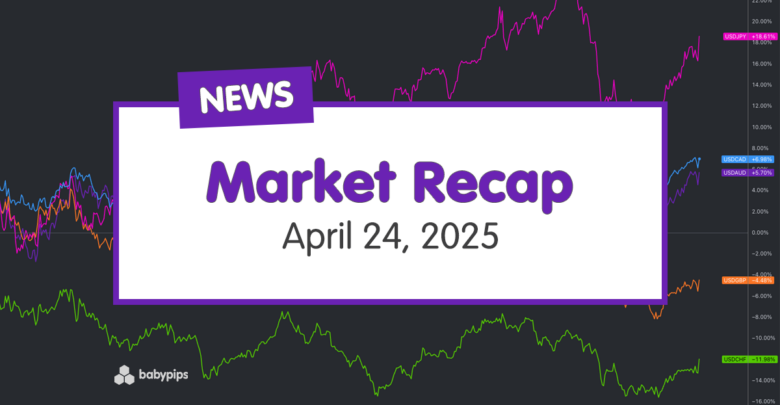Traders cautiously took risks on Thursday thanks to optimistic trade deal speculations, positive corporate earnings reports, and a bit of bargain hunting.
Meanwhile, the U.S. dollar gave up ground after China said, “U.S. government, STOP!” with its unilateral tariffs and insinuations of ongoing trade negotiations.
Here are the updates from the last trading sessions!
Headlines:
- China denied any trade talks with Washington, said the US should remove all “unilateral tariff measures” against China to solve trade issue
- Westpac – one of Australia’s largest banks – told mortgage holders to “lock in” a 25bps RBA rate cut in May
- France consumer confidence for April: 92.0 (91.0 forecast; 92.0 previous)
- Germany Ifo business climate for April: 86.9 (85.5 forecast; 86.7 previous); current conditions at 86.4 (85.5 forecast; 85.7 previous)
- U.K. CBI business optimism index for June 30: -33.0 (-40.0 forecast; -47.0 previous)
- U.S. initial jobless claims for April 19: 222.0k (218.0k forecast; 215.0k previous)
- U.S. durable goods orders for March: 9.2% (1.7% forecast; 0.9% previous); core durable goods orders at 0.0% (0.1% forecast; 0.7% previous)
- U.S. existing home sales for March: -5.9% m/m (-1.9% forecast; 4.2% previous)
- U.S. Kansas Fed manufacturing index for April: -5.0 (-2.0 forecast; 1.0 previous)
- ECB official Olli Rehn said that the central bank should not rule out a larger rate cut
- ECB official Knot: Medium-term tariffs impact on inflation still unclear
- U.S. Treasury Secretary Scott Bessent cheered a “very successful” meeting with South Korea, said they could reach an “agreement of understanding” as early as next week
- FOMC voting member Christopher Waller supports rate cuts if tariffs lead to layoffs
- FOMC alternate member Beth Hammack signaled possible June rate cut if there’s “clear and convincing” data
Broad Market Price Action:

Dollar Index, Gold, S&P 500, Oil, U.S. 10-yr Yield, Bitcoin Overlay Chart by TradingView
Markets continued their positive streak Thursday as U.S. and European stocks climbed for a third straight day. The S&P 500 gained 2% and the tech-heavy Nasdaq surged nearly 3%, with technology shares providing a solid boost after AI-powered software firm ServiceNow reported better-than-expected quarterly results.
European markets recovered from early weakness as investors focused on quarterly earnings and engaged in selective buying. Treasury Secretary Bessent hinted that extreme China tariffs aren’t “sustainable” and announced the U.S. may reach a trade understanding with South Korea “as soon as next week.” However, China denied any ongoing negotiations, insisting the U.S. must cancel all “unilateral” tariffs before bilateral talks can progress.
Gold rebounded to $3,332 an ounce, benefiting from bargain hunting following Wednesday’s sharp decline and a pullback in the U.S. dollar. Oil prices inched up slightly but remain down for the week amid concerns about potential increased OPEC+ production.
10-year Treasury yields fell to 4.31% as investors favored safer assets, while bitcoin remained steady around $93,600. Despite the market optimism, several major companies like PepsiCo and Procter & Gamble have warned that tariff uncertainty is forcing them to lower their profit forecasts.
FX Market Behavior: U.S. Dollar vs. Majors:

Overlay of USD vs. Major Currencies Chart by TradingView
The U.S. dollar lost ground across the board on Thursday, with the sharpest drop kicking off during the early European session. That’s when China’s Commerce Ministry denied any ongoing trade talks with the U.S. and demanded a full removal of tariffs, souring sentiment and hitting the Greenback hard.
The euro and pound gained momentum as European traders brushed off the trade headlines and focused on stronger equities and earnings reports. The German Ifo release didn’t spark major moves but supported a more upbeat market tone.
USD selling continued during the U.S. session. Jobless claims and durable goods orders came in soft, while existing home sales failed to spark any optimism. Risk appetite improved thanks to a strong rally in tech stocks, which further dragged on the dollar. Meanwhile, Fed officials floated the idea of rate cuts if tariffs hit the labor market, and Treasury Secretary Bessent hinted that the harsher China tariffs might not last, reinforcing the dovish bias.
By the end of the day, the Greenback had registered its largest losses against risk-sensitive currencies like the Australian and New Zealand dollars, while seeing more limited declines against the Canadian dollar, Japanese yen, and Swiss franc amid the improving risk environment.
Upcoming Potential Catalysts on the Economic Calendar:
- U.K. retail sales for March at 6:00 am GMT
- France business confidence for April at 6:45 am GMT
- SNB Chairman Schlegel speech at 8:00 am GMT
- Canada manufacturing sales (prel) for March at 12:30 pm GMT
- Canada retail sales for February at 12:30 pm GMT
- ECB member Buch speech at 2:00 pm GMT
- U.S. UoM consumer sentiment index for April at 2:00 pm GMT
- Canada budget balance for February at 3:00 pm GMT
European session traders will likely eye the U.K. retail sales and France’s business confidence for signs of resilience in consumer and business activity, both of which could spark volatility in GBP and EUR pairs. Chairman Schlegel’s speech may also get attention if the SNB head honcho talks currency intervention.
In the U.S., focus could shift to Canadian retail and manufacturing data, the University of Michigan consumer sentiment index, which could drive USD and CAD, especially if data lines up with any global trade-related update.
As always, stay nimble and don’t forget to check out our Forex Correlation Calculator when taking any trades!
